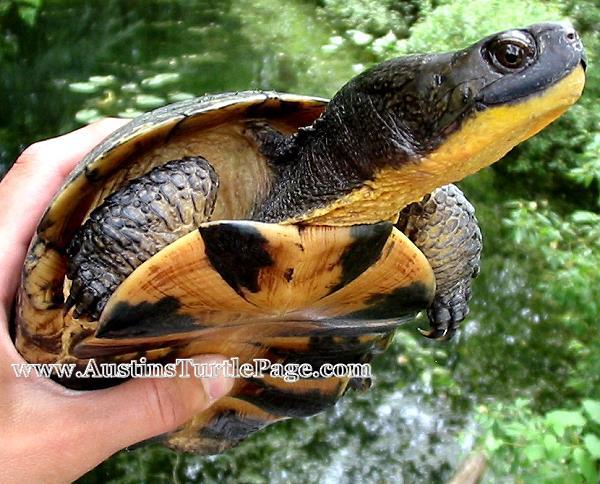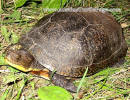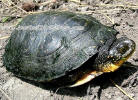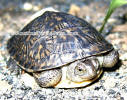|
|
|
|
|
Blanding’s turtles are medium-sized semi-terrestrial turtles similar in design to the basking turtles (i.e.: sliders) but with higher-domed carapaces, much longer necks & larger heads. Adults are known for black carapaces with myriad speckling, beautifully patterned plastrons & a striking yellow lower jaw (pattern & color varies somewhat across individuals). Unlike most U.S. basking turtles males reach slightly longer SCL’s (9-11”) than females (8-10”); specimens > 12” have been reported. Adult Blanding’s high domed carapaces lack keels or sculpturing (exempting younger juveniles with distinct growth annuli); with age the carapace is worn smooth. Male Blanding’s have relatively concave plastrons; females have flat plastrons and a shorter narrower tail than males. Blanding’s develop a slightly hinged plastron as they mature; while not as effective as a Box turtle, some Blanding’s can almost completely close the front lobe of the plastron. |
||
|
|
|
|
|
|
|
|
Found mainly throughout the great lakes area. Michigan,
Wisconsin, Illinois, Indiana, Ohio. Western populations can be found in found in
N. Iowa, Minnesota and Nebraska. Northernmost populations can be found in
Quebec, S. Ontario and Nova Scotia. Isolated populations have been reported in
Maine, New York, Pennsylvania (? Recent reports state they have been extirpated
from that state).
|
||
|
|
|
|
|
|
|
||||
TEMPERATURE RANGE (°F)
We recommend only experienced keepers or someone willing and
able to accommodate this medium to large species of turtle. Adult turtles will
need more space than the novice turtle keeper can likely provide. This active
species requir CAPTIVE DIET Blanding’s turtles are primarily a carnivorous species. In the wild their diet primarily consists of crustaceans (such as crayfish), insects and their larvae. Other aquatic invertebrates such as leeches and snails are readily accepted. Blanding’s are opportunistic feeders and eagerly take prey such as small fish and amphibians. Carrion will be eaten if the opportunity arises. Prey is captured with the aid of extremely long necks. They can extend their throats and literally suck in passing fish, etc. Their ‘vacuum-strike’ is similar to that of the Snapping turtle or Chicken turtle where the body lunges forward with the head. Though considered carnivorous, they have been reported to consume plant matter to some degree (Turtles of the United States and Canada Include Page & if research is cited make a Bibliography section & foot note this reference). Filamentous algae, Duckweed and Seeds can be ingested. I speculate this may just be from accidental ingestion while feeding on insect larvae or snails. They have been known to feed sparsely on succulent vegetation such as water hyacinth and Lilly’s. You can offer your turtle plant matter (Romaine, Anachris, Hornwort) it is really up to the individual turtle on what vegetation it will eat.RECOMMENDED FEEDING SCHEDULE Hatchling to sub adult turtles should be fed commercially prepared foods (i.e.: ReptoMin/Mazuri pellets) every other day, in moderation. I highly recommend sporadically offering small amounts of live prey to stimulate the turtles’ feeding response and let the turtle ‘hunt’ throughout its habitat. Adults can be fed every two or three days. Commercial pellets combined with live prey items (Minnows, Shiners, Snails, etc....variety is key). Romaine lettuce may be offered daily to those who eat it. Adults readily overeat; a close eye on weights and growth patterns. A Blanding’s overfed and growing excessively fast will exhibit a lightening of the new growth on the shell. An adult turtle should be able to retract its head and forearms/rear legs and tail into its shell and partially close the plastron/carapace with no problems. An overfed or obese individual will only be able to do one half at a time i.e. if it retracts its head and its rear legs hang out or you touch the rear legs and the turtle compensates by hanging out its head or front legs, Then it may be time to cut back on its food, Thus the importance of maintaining growth and weight data on your turtle. If you feed crayfish it recommended they be frozen to kill any parasites. CAPTIVE HABITAT Note: This is a description of their preferred wild habitat, but natural history informs captive husbandry, & since they are specific in their requirements, captive habitat design draws on this information. Blanding’s turtles prefer slow moving waters with little to no current present. Relatively any shallow soft bottomed body of water with heavy aquatic vegetation will be utilized by this species. They inhabit Marshes, Bogs, Vernal pools, Beaver ponds/streams and Shallow lakes. They are a semi terrestrial species, often found on land as they move throughout their range. In early spring Blanding’s can be found in seasonal wetlands where they look for mates and food. As conditions dry up throughout the summer they can and will travel considerable distance looking for acceptable habitat. Water temps seem to be a big factor in where they choose to reside. Any shallow marsh, if water temps exceed 80 F, will prompt the turtle to seek cooler temperatures, i.e. deeper pools or heavily vegetated/shaded ponds. RECOMMENDED ENCLOSURE Juveniles to adults will need housing with much more space than Hatchlings. For a 6 inch turtle, I recommend at least a 75 gallon tank with about a foot of water and a lot of structure for the turtle to climb through. Logs, aquatic plants and a basking spot or small land area for the turtle to bask on would be highly recommended. Adults can be housed in aquariums (135 to 175 for a single turtle) but at the size this species can reach, a stock tank of 200 gallons or more would be better suited for larger specimens. At best, if you’re able to provide them with an outdoor enclosure they will thrive as long as water temps are cool. Minimum size for an outdoor enclosure would be 6x8 with at least 1/3 land area. (outdoor enclosure climates are harder to ‘micromanage;’ space allows more security against over-heating, flooding, etc…). WATER DEPTH The depth of the water depends on the size of the turtle. Hatchlings should be kept in water no more than 2 inches deep (The turtle should be able to easily reach the surface without effort). Juveniles, sub adults and adults can tolerate deeper conditions as long as there is structure for them to rest on, or a sloping gradient allowing easy access to shallower waters. No matter what water depth is provided it is important to heavily plant the tank or enclosure (live or plastic plants, and driftwood). COMMUNITY HABITAT Blanding’s
turtles are typically non-aggressive turtles and can cohabit with a variety of
other species. Take care at feeding time to prevent fights over food. Male
Blanding’s turtles will fight if not provided enough
space or sight breaks to escape from one another. Same goes for male/female |
||||||
|
|
|
|
|
|
|
|
In the wild it can take
Blanding’s
turtles on average 14 to 20 years to reach sexual maturity. It takes
much less in captivity due to faster captive growth rates. To
prepare for breeding a 3 month cool down period is recommended (but
not required, as I know people who've had success without one).
Copulation takes place in late fall/early spring (in captivity,
whenever the female is receptive); three to six weeks after
copulation the female should be palpitated for eggs. This is done by
feeling the abdomen directly in front of the hind legs. If she is
gravid, the eggs should be felt as hard lumps within the body
cavity. Provide a nesting area at this
point. Ten inches of soft loamy topsoil should serve as substrate.
The female will dig a few test nests before finding the right
conditions to lay. In an outdoor
enclosure, eggs can be left in the ground for natural incubation or
removed and artificially incubated. Average clutch size can vary
from 9 to 20 eggs.
|
||
|
|
|
|
|
|
|
|
ENCLOSURE Hatchling Blanding’s can be setup in as little as a 10 to 20 gallon long. It is important to provide hatchlings with very shallow water. A good rule of thumb is for a water depth that allows the turtle to be able to reach the surface while standing on the bottom of the tank. Depth can be slightly increased as the turtle grows. They are not the best swimmers so a lot of structure will be needed. Aquatic plants are great for a variety of reasons. 1. They provide cover for the hatchling to hide in. 2. They are not great swimmers and prefer to pull or crawl through the water to stalk prey or rest at the water’s surface. 3. The decaying plant matter will slightly acidify the water (and give it a tannish appearance); this helps prevent the growth of mold and fungus. In the wild hatchlings to juveniles are found primarily in shallow pools or bogs that have a lot of decaying plant matter. So if they seek out these conditions in the wild, it should be as closely replicated at home as possible. A basking spot as simple as a rock or log should be placed on one side of the tank under a full spectrum UVB bulb (50 watt should be sufficient). Blanding’s bask & require a warm basking area. You can provide this warmth with a ceramic heat emitter, basking light bulb or mercury vapor UV-B & heat bulb. If a heat emitter or non-UV-B basking bulb is used, consider a reputable fluorescent UV-B bulb like the ReptiSun 5.0. UV-B lighting is probably not critical if dietary Vitamin D3 content is sufficient, but if you have any doubts, it’s worthwhile ‘just in case.’ A timer will provide a consistent photoperiod & be very convenient. DIET Hatchlings take a wide variety of foods. Commercial turtle foods such as ReptoMin can make up the bulk of the diet, but vary it. Feeder fish and insects will be greedily devoured. Crustaceans such as ghost shrimp and dried Gammarus shrimp or small crayfish should be offered, due to the prevalence of these items in the wild diet. They will eat most anything that moves. Caution -
Hatchlings are overzealous eaters and grow at extremely fast rates if allowed to
do so.
They can literally ‘gorge’ themselves to death. I
speculate this is due to drowning (if the stomach becomes so engorged it takes
up most of the space inside the carapace it will leave little room for air in
the lungs, interfering with the turtle’s ability to regulate its buoyancy (in
theory), so it's better to feed younger turtles smaller amounts more frequently
than large amounts all at once. Note: some amphibians outside of this turtle’s natural range can be highly toxic and should not be included in their diet! Bullfrogs, Leopard and Green frogs along with spring peepers would be considered safe. |
||
|
|
|
|
|
|
|
|
In summary the Blanding’s turtle can make a rewarding pet if
you are able to appreciate it and provide it the space it needs to live happily. Note: Blandings turtles are in steady decline throughout much of the home range are considered threatened to endangered or as a species of special concern, so check your state laws before you consider working with this species. Temperament: Blanding’s are generally extremely docile turtles and rarely resort to biting unless provoked. With all the wild Blandings I’ve handled over the years, not one ever attempted to bite, although hand feeding can be risky as they are voracious and may get the hand that feeds them instead. BEHAVIORAL NOTES: Activity Cycle: Blanding’s are very cold tolerant species. They emerge from hibernation as early as May (or earlier). In the spring they spend considerable time wandering over land looking for mates or habitat. They are a diurnal species actively foraging during early morning hours and late evening. At dusk they prefer to burrow into the vegetation until dawn. They remain active throughout November and I’ve seen them slowly moving under the ice in January. They spend most of their time moving through thick vegetation and can be found moving over land on warm humid rainy days. Personability with Humans: Blandings are very docile if not shy species to keep. It’s really up to the individual turtle on whether or not it trusts you. I have handled wild specimens that will refuse to come out of their shells while others’ seem’ quite personable. They can be secretive but will beg for food at anytime. Basking: Blanding’s bask on cooler sunny days using logs and submerged mats of vegetation or tussocks of grass. In periods of warmer weather, they bask crepuscular (under banks or hidden in tall weeds. In captivity offer a choice of basking spots (at least one under direct light, and one relying on ambient air temp.). They will make the suitable choice. BIBLIOGRAPHY 1.) Turtles of The United States and Canada –Carl H. Ernst, Jeffrey E. Lovich and Roger W. Barbour. Smithsonian Institution Press, Washington and London. ©1994. (Possibly the preeminent natural history text of North American turtles – very highly recommended). 2.) Amphibians and reptiles of the great likes region- James h Harding. |
||
|
|
|




